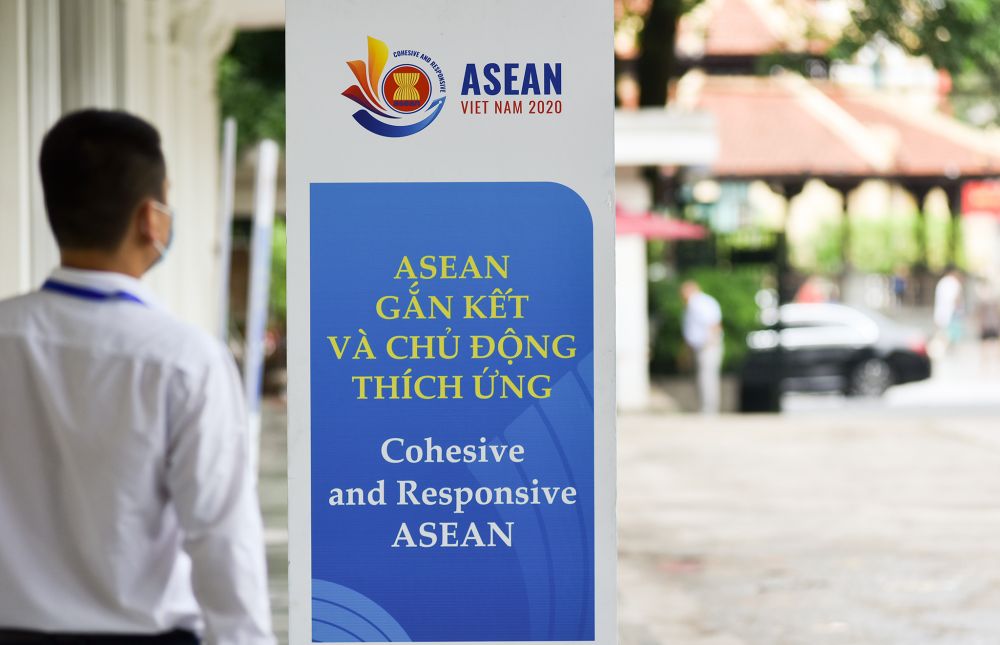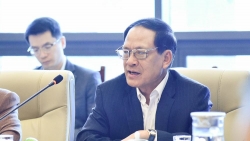
ASEAN economic power in the new normal
Latest
| TIN LIÊN QUAN | |
| The leading role of Chair of ASEAN for 2020 has been proven | |
| Viet Nam, ASEAN and the solidarity amid difficulties | |
 |
| ASEAN economic power in the new normal. |
As ASEAN Chair 2020, this year, Viet Nam have raised and together with ASEAN undertaken 20 initiatives in all fields of economy, trade, investment, and technology. Along with existing FTAs between ASEAN and its partners, a new agreement planned to be signed, the Regional Comprehensive Economic Partnership (RCEP), will certainly create new turning points in regional economic cooperation.
From a responsive ASEAN…
Founded in December 2015, the ASEAN Economic Community (AEC) demonstrated a shared vision among ASEAN leaders. The AEC and ASEAN Vision 2025 constitute the basic and key directions to ensure ASEAN’s position and role as a hub of Southeast Asia, East Asia and the Asia-Pacific, steering the path of prosperity and development for Viet Nam and other ASEAN member states.
In 2020, COVID-19 has become the biggest obstacle facing Viet Nam - the ASEAN Chair. However, later August 2020, under the chair of Viet Nam, the 52nd Meeting of the ASEAN Economic Ministers (AEM) and related meetings were successfully organized in a new format - video conference. Despite this novel format, all discussions reached solutions to implement the AEC Blueprint 2025, particularly the assessment and adjustment of the Blueprint to the new regional landscape, helping ASEAN overcome challenges on a global scale and quickly recover the economy in the post-pandemic period.
In the active adaptation to the pandemic raging across the region, as ASEAN Chair 2020, Viet Nam has proactively coordinated with member countries and the ASEAN Secretariat to develop a series of new contents added to the Summits and cooperation mechanisms between ASEAN and the plus three countries, Japan, China, and the Republic of Korea (ASEAN+3), and other partners, to ensure the objectives and requirements in response to COVID-19, as well as to facilitate ASEAN economic development.
In the new context, ASEAN economic Ministers have agreed to maintain existing commitments to opening markets in trade and investment, refraining from applying measures that unnecessarily restrict trade, stepping up trade facilitation measures to stabilize production and supply chain connectivity, and developing a post-pandemic recovery plan.
Close intra-bloc cooperation has contributed to a larger and more extensive ASEAN economic space. At the same time, issues agreed by ASEAN members also aimed to a more cohesive economic space, so that it shall be a leverage for ASEAN’s competition with other regions in the world. The shared economic space will increase intra-regional strength, enhance the role of the AEC, and help ASEAN proactively respond to non-traditional challenges in the future.
Statements, initiatives and action plans have laid an important foundation for ASEAN and partner countries to carry out necessary solutions to together overcome the pandemic and promote sustainable growth. All parties concerned have discussed and sought to resolve drawbacks in cooperation within ASEAN as well as between ASEAN and its partners.
Cooperation in the new normal
It can be said that ASEAN economic integration plays an important role and presents the first step in Viet Nam’s international integration. Through ASEAN, Viet Nam taps into huge potentials to access regional and global economy. It is the Viet Nam-ASEAN cooperation in all areas and aspects in which economics is a pillar that has brought about Viet Nam’s a significant position today, in politics, foreign affairs and economics.
ASEAN is currently the leading trade partner of Viet Nam. When Viet Nam first joined the ASEAN Free Trade Area (AFTA) in 1996, our two-way trade with other members reached only about 6 billion USD. This number has exceeded 60 billion USD, a 10-fold increase, nowadays.
| To date, Viet Nam has signed 16 FTAs, many of which are new generation FTAs, covering all of the world’s largest economies. Up to 15 out of 20 countries in the G20 have signed FTAs with Viet Nam, a proof of Viet Nam’s greatly enhanced capacity, position, and image. |
ASEAN economic integration not only provides opportunities to boost world trade cooperation, but also contributes significantly to Viet Nam’s processes of economic restructuring and connecting reforming growth model with building a rule of law nation based on a socialist-oriented market economy.
The 4th industrial revolution, digital economy, trade protectionism, unilateral trade, among others are posing huge challenges to the rules-based multilateral trade system, including the AFTA frameworks. How to bolster ASEAN’s adaptability, increase connectivity in entrepreneurship and e-commerce, and break down barriers to trade liberalization are the priorities Viet Nam has determined in our ASEAN Chairmanship 2020.
These priorities require Viet Nam and other ASEAN member states to reaffirm our cooperation at a higher level in a new context, with suitable economic connectivity and linkages in the new normal. We must sustain our adaptability and resilience to new developments, thereby generating new vitality for ASEAN and cooperation frameworks between ASEAN and its partners.
… To the RCEP’s aspiration
The RCEP is considered critical amid the economic uncertainty caused by COVID-19. The signing of the RCEP therefore receives further expectation of becoming the basis to strengthen the confidence of the business community and the structure of the regional economy, as well as pledging regional support for an open, synchronous and regulations-based multilateral trade system.
| After multiple rounds of negotiations since 2012 among 10 ASEAN member countries and 6 dialogue partners, the RCEP will become the world’s largest free trade area committing to opening markets in the sectors of goods, services and investment, simplifying customs procedures and rules of origin, and facilitating trade. |
As negotiations began, all countries had concurred with the goal of a comprehensive, high-quality free trade agreement that benefits all. Among relevant parties, some have signed FTAs with each other, with different degrees of economic openness, while others have not reached an FTA. Thus, a common degree of economic openness for all parties is ambitious. In addition to the large scale of the Agreement, economic development levels varies from state to state, with different policies on negotiation areas such as competition, investment, and intellectual property.
Above all, the RCEP is expected to strongly promote the expansion of regional and global value chains in the near future, boosting economic growth for ASEAN countries. Particularly for Viet Nam, the RCEP’s implementation will open up more opportunities for Vietnamese businesses to increase export, participate in new value chains in the region, and better attract foreign investment.
Regarded as the largest FTA in the world, the RCEP will create a market with a size of about 3.5 billion consumers and a GDP of approximately 49,000 billion USD, accounting for about 39% of global GDP. It is expected to create new landscape and structure for regional and international trade. The RCEP is believed to play an important role in post-COVID-19 economic recovery, contributing to the stable economic growth in the region and the world.

| The ASEAN Socio-Cultural Community Blueprint 2025: Opportunities and Challenges to Viet Nam The ASEAN Socio-Cultural Community play special roles, both as the goals and the basis of building and strengthening the ASEAN Community. |

| The leading role of Chair of ASEAN for 2020 has been proven As the Chair, Viet Nam has been flexible and proactively turned challenges into opportunities. |

| Viet Nam, ASEAN and the solidarity amid difficulties Ha Noi has been surprisingly creative in its diplomatic actions and made the best use of the situation, not only for Viet Nam but for ... |

























